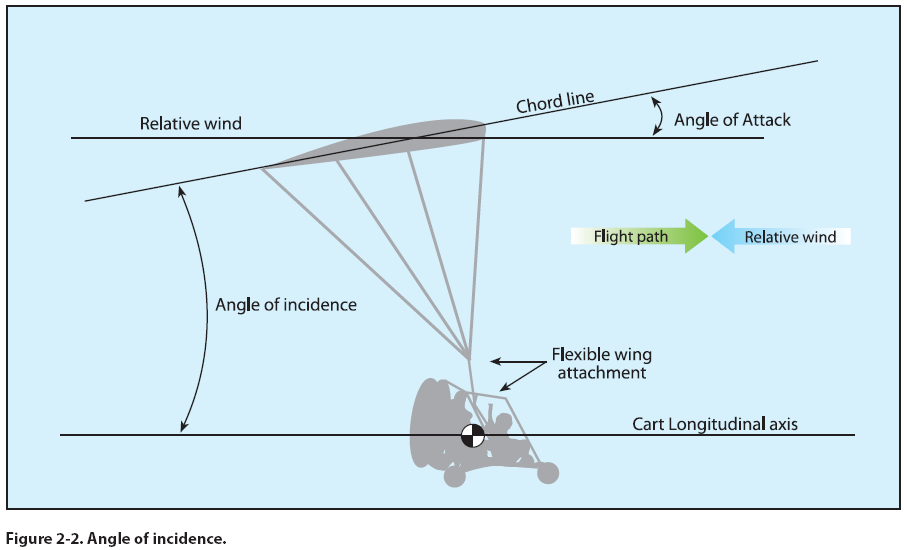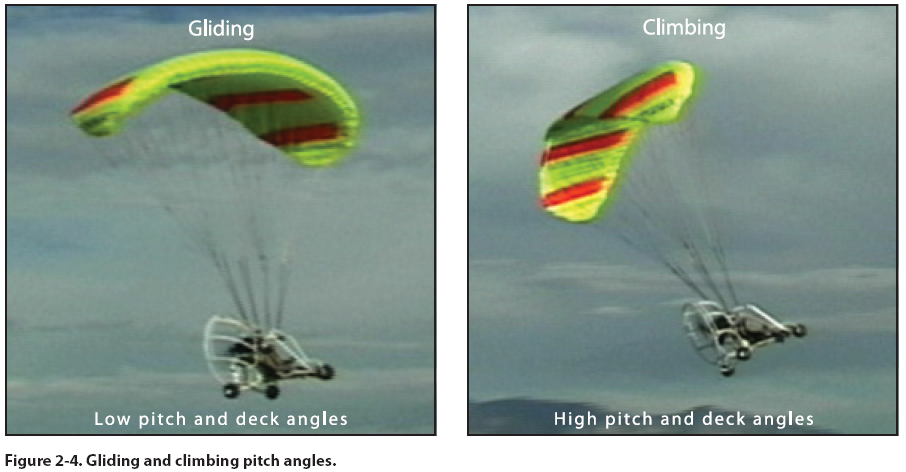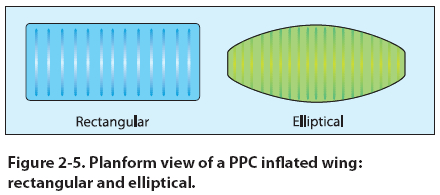|

Chapters 2 and 3 of the Pilot’s Handbook of Aeronautical
Knowledge (FAA-H-8083-25) apply to powered
parachutes and are a prerequisite to reading this book.
This chapter will focus on the aerodynamic fundamentals
unique to powered parachute (PPC) operations.
Aerodynamic Terms
Airfoil is the term used for surfaces on a powered
parachute that produce lift, typically the wing itself.
Although many different airfoil designs exist, all airfoils
produce lift in a similar manner.
Camber refers to the curvature of a wing when looking
at a cross section. A wing possesses upper camber
on its top surface and lower camber on its bottom
surface. Leading edge describes the forward edge of
the airfoil. The rear edge of the airfoil is called the
trailing edge. The chord line is an imaginary straight
line drawn from the leading edge to the trailing edge.
[Figure 2-1]

Relative wind is the direction of the airflow with respect
to the wing; it is usually parallel to and opposite
the PPC flight path. Relative wind may be affected
by movement of the PPC through the air, as well as by
all forms of unstable, disturbed air such as wind shear,
thermals, turbulence, and mountain rotors. When a
PPC is flying through undisturbed air, the relative
wind is parallel to and opposite the flight path.
Angle of attack is the angle between the relative wind
and the wing chord line. [Figure 2-2]

Longitudinal axis is an imaginary line about which
the aircraft rolls; it is also called the roll axis. The
longitudinal axis is not a fixed line through the cart
because the angle of incidence changes in turbulence
and with loading changes.
Angle of incidence is the angle formed by the chord
line of the wing and the longitudinal axis of the PPC
cart. The cart longitudinal axis is not the same as the
aerodynamic longitudinal axis defined in the previous
paragraph. [Figure 2-2] Unlike an airplane, the angle
of incidence can change in flight because of the flexible
line attachment between the wing and the cart.
Angle of incidence can change for different types of
flight configurations and PPC designs; this is covered
in detail in the “Moments” section.
Trim angle is the angle between the chord line of the
wing and the horizontal plane when the PPC is in nonpowered
gliding flight. [Figure 2-3] The PPC wing is
designed at a slight angle, with the chord line inclined
downward to the horizontal plane to maintain the
manufacturer-designed angle of attack during gliding,
level and climbing flight. This “trim angle” is built
into the powered parachute by the manufacturer and
cannot be adjusted by the pilot moving the controls.

Pitch angle is the angle the PPC wing chord makes
with the horizontal plane. Pitch angle is what you can
see. Many pilots confuse the pitch angle, which you
can easily see and feel, with the angle of attack which
may not be as perceptible. [Figure 2-4] For example,
the pitch angle in an engine-out glide could be minus
8 degrees, in level flight 10 degrees above the horizon,
and in a climb it could be 28 degrees above the
horizon. These are significantly different angles you
easily see. Pitch angles are covered in greater detail
in Chapter 6.

Deck angle is the angle of the cart’s lower frame
(from the front wheel to the rear wheels), to the landing
surface. The deck on the lower part of the conventional
cart frame can be used to visualize deck angle.
An imaginary line between the front and back wheel
axles can also be used on unconventional carts.
from above. The PPC wing comes in two wing planforms:
rectangular, and elliptical. [Figure 2-5] The elliptical
planform leading and trailing edges are curved
to form an elliptical shape when viewed from the top
or bottom. These two shapes have unique flying characteristics.
Rectangular wings typically produce more
drag, are lower-performance, and do not move fore
and aft, relative to the cart, as quickly as elliptical
wings. These characteristics are more obvious when
the wing is inflating, during pitch changes, and when
flying in turbulence. Rectangular wings are therefore
more stable and require less effort to fly. Elliptical
wings are higher-performance and more efficient due
to less drag. Elliptical wings react more quickly with
changing conditions and require greater pilot experience
and skill during inflation, in turbulent air, and
with abrupt throttle changes.

Aspect ratio is the wingspan divided by the average
chord line. A PPC with a common 500-square foot
rectangular wing (about a 38-foot wingspan) and with
a typical mean chord line of 13 feet, would have an
average aspect ratio of about 3. This relatively low
aspect ratio is less efficient at producing lift. An elliptical
wing with the same 500 square feet and a 45-foot
wing span and an 11-foot average chord would have
an aspect ratio of about 4. The PPC wing is similar to
airplane wings in that the aspect ratio will differ with
the specific design mission for the aircraft. Generally, rectangular wings have lower aspect ratios and lower
efficiency than the higher aspect ratio and higher efficiency
elliptical wings. Generally, a high aspect ratio
wing, compared to a low aspect ratio wing, produces
higher lift at lower angles of attack with less induced
drag. [Figure 2-6].

Wing loading is a term associated with the total
weight the ram-air wing must support. Wing loading
is found by dividing the total weight of the aircraft, in
pounds, by the total area of the wing, in square feet.
Wing loading is found by dividing the weight of the
aircraft, in pounds, by the total area of the wing, in
square feet. For example, the wing loading would be
2.0 pounds per square foot when 1,000 pounds—a
common weight for a two-seat PPC with two people
— is under a 500-square foot wing. If flying with one
person the aircraft weight might be 700 pounds and
the wing loading would decrease to 1.4 pounds per
square foot.
Gliding flight is flying in a descent with the engine at
idle or shut off.
|

